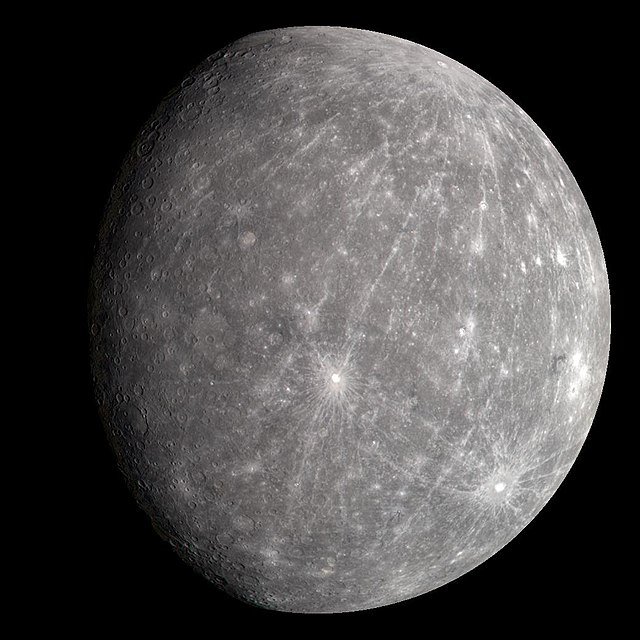Nestled closest to the Sun, Mercury, the smallest and swiftest planet in our solar system, has long captivated the curiosity of astronomers and stargazers alike. Despite its proximity to our celestial neighbor, Mercury remains a mysterious world with unique characteristics that set it apart.
Orbital period: 88 days
Distance from Sun: 58 million km
Length of day: 59d 0h 0m
Radius: 2,439.7 km
Gravity: 3.7 m/s²
Surface area: 74.8 million km²
Mass: 3.285 × 10^23 kg (0.055 M⊕)
Proximity To The Sun
Mercury’s orbital dance places it at an average distance of about 58 million miles from the Sun, making it the closest planet in our solar system. This proximity results in extreme temperature variations, with surface temperatures soaring to scorching highs of around 800 degrees Fahrenheit (430 degrees Celsius) during the day, only to plummet to chilling lows of -290 degrees Fahrenheit (-180 degrees Celsius) at night.
Orbit
Mercury boasts the fastest orbital speed among all planets, completing its journey around the Sun in just about 88 Earth days. This rapid orbit has fascinated astronomers for centuries, as it defies conventional expectations of a planet’s leisurely journey around its parent star.
Tidally Locked Rotation
An intriguing aspect of Mercury’s relationship with the Sun is its tidally locked rotation, meaning it rotates on its axis exactly three times for every two orbits around the Sun. This unique dance results in peculiar consequences, such as one side of the planet experiencing perpetual daylight while the other remains entrenched in perpetual darkness.
Thin Atmosphere
Mercury’s atmosphere, or lack thereof, adds to its allure. Composed mainly of oxygen, sodium, and hydrogen, the thin exosphere does little to shield the planet from the Sun’s intense radiation. This scarcity of atmosphere contributes to extreme temperature differentials and a surface that echoes the scars of ancient impacts.
Striking Surface Features
The landscape of Mercury is a testament to the relentless bombardment it has endured over eons. Scarred by craters, expansive plains, and towering cliffs, the planet’s surface tells a story of a tumultuous history shaped by asteroid and comet impacts.
Messenger Mission Revelations
Our understanding of Mercury has been significantly enriched by NASA’s Messenger mission, which orbited the planet from 2011 to 2015. NASA’s Mariner 10 marked the initial visitation to Mercury, capturing images of approximately 45% of its surface. Subsequently, NASA’s MESSENGER spacecraft conducted three flybys and spent four years in orbit around the planet before concluding its mission with a controlled descent to the surface. In 2018, a collaborative effort between the European Space Agency and JAXA led to the launch of BepiColombo, a mission comprising two spacecraft. The mission strategizes nine flybys to guide the spacecraft into its intended orbit by late 2025.

When observed from the surface of Mercury, the Sun would seem over three times larger than its appearance from Earth, casting sunlight that is up to 11 times brighter. Despite its proximity to the Sun, Mercury is not the hottest planet in our solar system— that title belongs to nearby Venus, thanks to its dense atmosphere.
Fun Facts!
Not only is Mercury the smallest planet, it is also shrinking!
- In a very, very slow process, Mercury is getting smaller every day. It is estimated that the planet is about 9 miles smaller than it was four billion years ago. Astronomers believe this is happening because it’s iron core is cooling, which is making it solid, therefore reducing the planet’s volume.
Mercury has the most craters in the Solar System
- Because Mercury’s atmosphere is so weak, the planet has nothing to protect it against meteor impacts. This has filled its surface of crater impacts and has given Mercury a very similar look to our Moon.
- The biggest crater in Mercury could fit Western Europe
Mercury doesn’t have any moons
- Due to its small size, low gravity and closeness to the Sun, Mercury isn’t able to keep a Moon in place. The only other planet in the Solar System without moons is Venus.
Mercury’s surface has ice on it
- In 2012, NASA’s MESSENGER spacecraft discovered water ice inside some of Mercury’s craters.Being so close to the sun, you might find it strange that Mercury could harbor any surface ice at all. But some parts of Mercury receives very little direct sunlight, and some craters remain constantly in the dark.
https://science.nasa.gov/mercury/